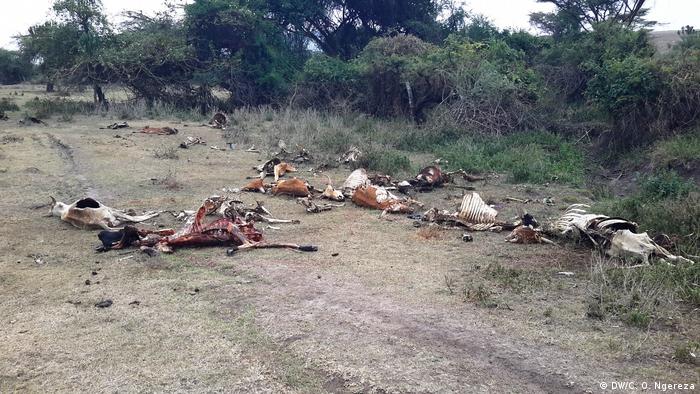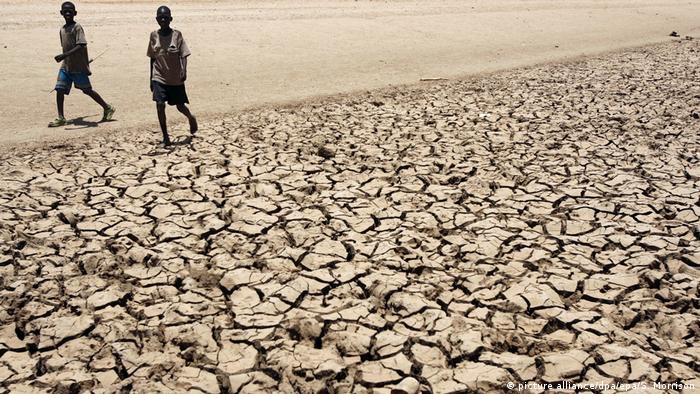Date: Thu, 16 Feb 2017 20:26:55 +0100
Up to 20 million threatened by drought in eastern Africa
A persistent drought caused by the El Nino weather phenomena is causing hunger and suffering for millions living near the east coast of Africa.
Author Gwendolin Hilse
Date 16.02.2017
Catastrophic images of whole herds of animals dying from the lack of water are being seen around the world. In some places camel carcasses are being stacked up as even the world's most robust animal has not been able to survive this persistent drought.
"We are seeing similar warning signals as in 2011 when more than 260,000 people died during the famine in Somalia," said Karl-Otto Zentel, secretary general of the relief organization CARE (Germany-Luxemburg). At the time, aid workers raised the alarm months in advance but the international community failed to act.
"We must not wait again until we see pictures of dying children," he added.
From the Horn of Africa to the Cape of Good Hope, drought continues to impact the east coast of Africa. According to the United Nations, at least 12 million people in the region are now dependent on humanitarian aid. In Kenya, Somalia and Ethiopia, the drought has been particularly severe mainly because of the El Nino weather phenomenon. It has caused extreme weather meaning that rainy seasons did not materialize which devastated crops.
According to the UN World Food Program's Chief Economist Arif Husain, the global humanitarian system is already struggling with a historic surge in migration plus huge operations in Syria, Iraq and Afghanistan. It also faces precarious situations in Ukraine, Burundi, Libya and Zimbabwe.
"It's almost overwhelming to comprehend that in the 21st century people are still experiencing famines of such magnitude. We're talking about 20 million people, and all this within the next six months, or now," he told Reuters.
Cattle dying off
Somalia has been worst hit by the drought. In the north of the country, the first deaths from hunger have now been reported. The UN says more than 40 percent of the population depends on food aid. At least 360,000 children are malnourished and about 70,000 of them are in danger of starvation.
Tens of thousands of families have left their homes in search of water and grazing land for their livestock. Neighboring Ethiopia is also recording the worst drought in half a century. The additional refugees coming from Somalia represent a further burden on the country, which is already struggling to feed its populace.
Kenya has declared a national emergency as the drought expands across the region. In the poor north of the country, on the border with Ethiopia, 70 percent of water sources are already dry. Many families have not eaten anything for days.
The drought is also a growing concern in Tanzania where almost 70 percent of the population depend on agriculture for their livelihoods.
"Our livestock has completely lost its value, because the animals are so emaciated," a cattle breeder from the Arusha region told DW.
Because many people want to get rid of their cattle quickly, prices are continuing to fall. "For a complete goat, I get only one shell of corn and I have to process it, which costs money again." At the same time, prices for basic food stuff have almost doubled since last year.
Dry fields everywhere
Even in the otherwise green country of Burundi, the fields are dry this year.
"You can see how dry it is here in Muyinga. The beans are yellow in the fields," said farmer Methode Nirora gesturing wistfully toward a barren hill that was once green with vegetation.
"We are still farming but we are not harvesting anything. Some farmers are opting to leave their fields and go to the refugee camps to get something to eat," he added.
While heavy rainfall in the south of Mozambique is now causing flooding, drought conditions are continuing in the center and north of the country.
"We used to harvest potatoes, when they were gone, we started to eat mangoes," farmer Emilio Paulo told DW. But now there are no more mangoes.
"We do not know what to do anymore. We really do not have anything left," he added. Some people are now turning to traditional healers, asking them to bring more rain.
Urgent help needed
The governments of eastern Africa are raising the alarm. Kenyan President Uhuru Kenyatta has already asked the international community for help. He promised that the Kenyan government was ready to provide up to 95 million euros ($100 million) and would do everything possible to help the affected communities.
According to a spokesperson, the government wants to allow further imports of corn and to expand the distribution of financial aid, water and food. At the same time, President Kenyatta urged food aid organizations not to try to profit from the crisis.
"I will not tolerate anyone who tries to exploit this situation in order to misappropriate public funds," he said.
Although the Kenyan government, the United Nations and international organizations have already made significant contributions, they have not sufficed to help the crisis because of the speed at which the number of starving people is increasing, Abbas Gullet, Secretary General of the Red Cross in Kenya told DW.
"The Kenyans are now acting to help their brothers and sisters," said Gullet. "If better-off Kenyans donate about 30 euros a month, then we can feed a family of five to six people."


